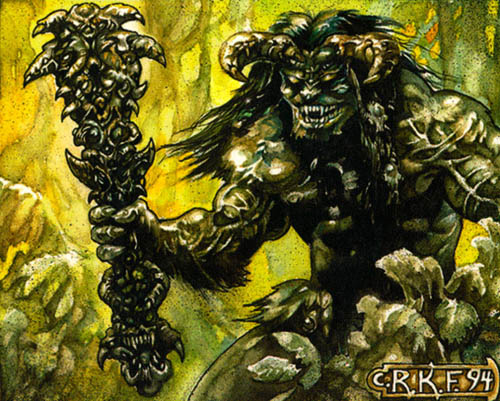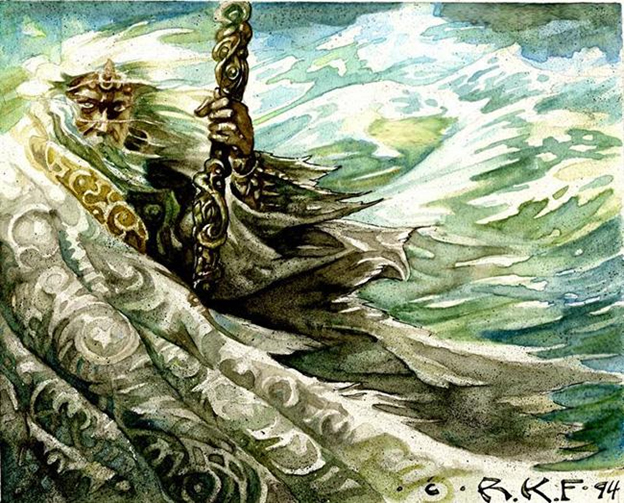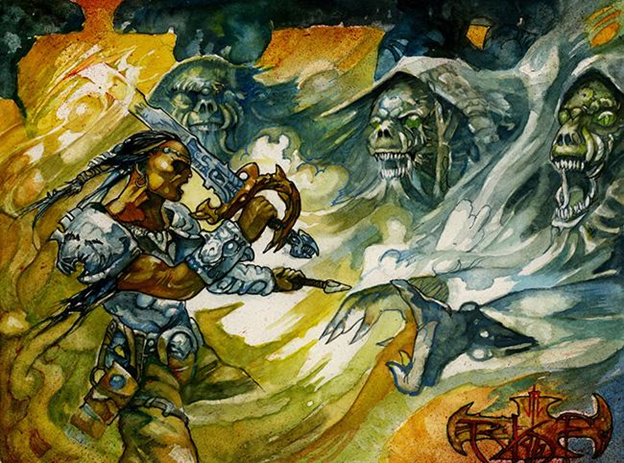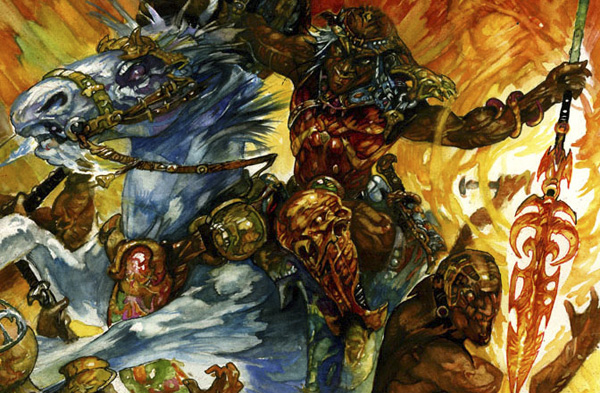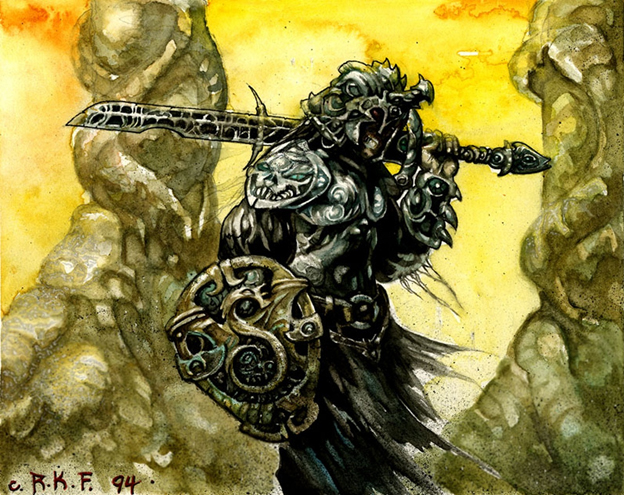
Dakkon Blackblade was just the beginning.
Grand Prix Baltimore 2014 was my first Grand Prix. One row of tables at this convention center held more players than I’d ever shared a space with total. A quiet kid from a quiet street who spent his adult life making sure he never had to be in a room with more than fifty people now found himself shoulder to shoulder with over twelve hundred . . .
So why bother? Why the driving and the expenses and the headache of being a suburban mouse trying to navigate downtown Baltimore on the same day as the Army–Navy game?
My people were there.
Matt Stewart and Eric Deschamps were in attendance for starters, both gentlemen and amazing artists. Boss of bosses Adam Styborski was also on site for event coverage. Bryon Wackwitz turned up as well, a storied artist and director and one of the driving forces behind the early days of Wizards of the Coast. But for me, there was a singular image on the registration site that caught my eye and turned my maybe into a hell yes.
Richard. Kane. Ferguson.
There’s something to be said for the instant connection you sometimes experience with another person through his or her art. Making my way to the far side of the convention hall, I found a man who I knew without introduction had to be Richard. His table propped up on boxes so he could work on his feet, there was a man talking, laughing, shaking hands, and doing ten things at once with vicious enthusiasm.
I liken Richard to the druid of the alpha artists—the wild and wise man of the trees. Like the artist himself, his work is vibrating with energy, pushing up against the side of the frame like a dam about to burst. Onion and parfait jokes aside, there are layers to these paintings and layers to this painter.
Moving Mountains: All in a Day’s Work
There are always challenges to properly representing a person’s career in the span of a relatively short article. Never has this been such an issue as it has with RKF. A quick Google search unleashes a torrent of work; any time spent following the man on Facebook reveals a mind in perpetual motion.
I’m reminded of a famous quote from radio personality Ira Glass.
Sounds nice, doesn’t it? You just dig in, day after day after day, and all will be well. It seems too good to be true, a notion many of us constantly struggle with. We don’t want to believe it. We want to be off the proverbial hook for having to put in the hours. There has to be a magic bullet. Then you have evidence like this:
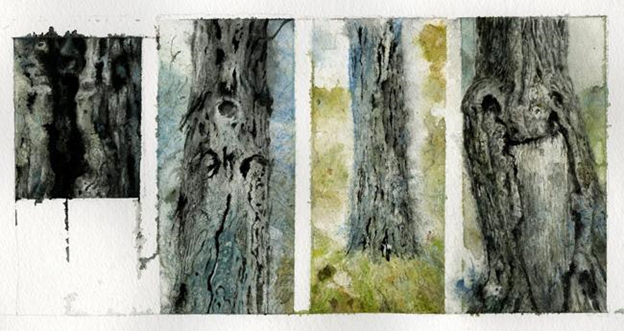
“Found these 4 old boys yesterday while taking a walk in my lower field and thought they would make good subject matter. Couldn't resist the sequential motif. Nice day painting outside. Getting quiet now that summer is long gone. There's a stillness in the air and everything is going to sleep.”
There is no such thing as someone who made it, only those who are making it. Every single day.
Richard was exposed to artwork of a high caliber from day one. His father, an art and antique dealer, would bring home books, manuscripts, and pieces from the auction block, while his mother produced paintings as well, an artist in her own right. This kept Ferguson in a constantly creative environment through his childhood and into early adulthood. Well before Malcolm Gladwell published his work on skill acquisition, Richard Kane Ferguson was already racking up his ten thousand hours of practice.
Most of his twenties were spent struggling, gloriously, with his art. He had reached a point in his progression at which he felt the call to seek out his own identity, his sense of individual style. He began to break down the process of image making by approaching it from different angles and working in different mediums. It wasn’t a short struggle either, lasting a good six or seven years. But he came out of the period in his mid-twenties with a kernel of truth, an unshakable knowledge of his original voice. His style now had a spoke, a core element that served as the epicenter for his craft.
As he has continued to create, Richard has continued to evolve. Lately, he’s been integrating elements of his more personal fine art with commercial work. He’s seeing a change in the market that’s creating crossover appeal, an emerging audience with sophisticated tastes that enjoy the sensibilities of traditional fantasy art. Galleries are also taking more commercially-oriented work to subsidize more traditional pieces. As a creator-in-progress, Richard’s been able to adapt with the times and realize the rewards.
If you want to see what fifteen years of practice and artist growth can do, you’re in luck; we as viewers in this digital age have access to an artist’s work at any stage in his or her career.
This piece is classic Ferguson from a golden era in MTG artwork. Here, we see many of Richard’s trademark techniques, using a strong sense of motion to guide the eye through the piece. From the movement of the energy waves in the background to the flow of the heroes’ clothing and armor, up around the ponytail, into the hood of the middle spectre, and down back around to begin the cycle all over again. A blue card, it pulls a lot of its darker hues from the border and color identity, mixing in some olive to complement the fiery orange of the skin and background. The silky-smooth watercolor is given just a little bit of texture here and there with some fine red mist, and colored-pencil-plus-ink work helps to complete the image to ensure nothing gets lost. Pure professional.
Now let’s fast-forward seventeen years.
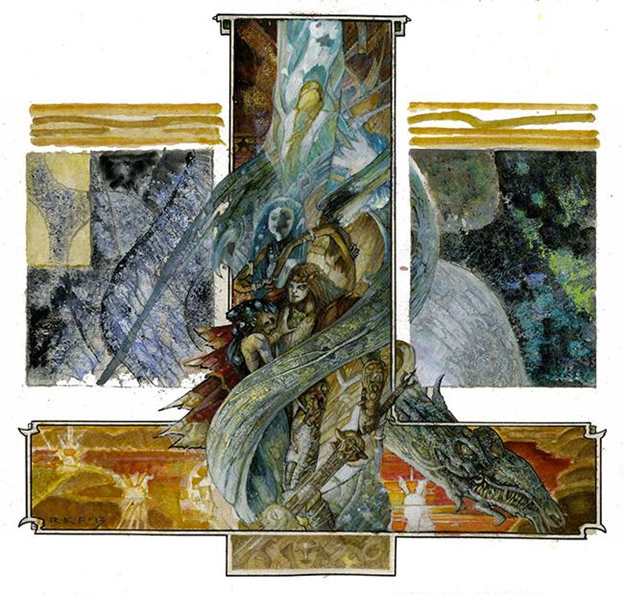
The Beguiling
Wow.
There’s a lot to be said about this piece, an article in and of itself. Even after multiple viewings, I’m still finding new things—which is the real point I’d like to make on the new work. This is not to say that the new artworks are “better,” but there is fundamental difference: confidence of presentation.
In Arcane Denial, we’re being presented with everything we need to know at a glance. In all fairness, it is for a gaming card, and there’s only so much detail you can cram into a reduction, but there is an aura of confidence in The Beguiling that is new to Richard’s work. And when I say confidence, I want to be very specific because this is not about RKF’s confidence in himself.
It’s about his confidence in us, the audience.
Leaving pieces of the image “raw” as he does on the two boxes that flank the main column, Richard is trusting our eye to complete the image. He’s pulling back the curtain on his process, allowing us to see the textural layers that were once so carefully tucked away. We are still treated to a fully rendered image of the figures at the focal of the piece. Their pose, the texture of the dragon that entwines them, the ghosted images that surround them—it waxes of a subtlety that can only be unraveled through continual and repeated viewing. This is the genuine image making that Richard is exploring now; this is the point of convergence where artistic inspiration meets professional skill.
“The art I love I could stare at all day long.”
A Man of Long Walks and Big Brush Strokes
I was about ten minutes into my phone interview with Richard when we were both silenced by the sound of an enormous dog barking on his end of the line. With some level of indignation, he shouted back, “I’m on the phone!”
Unconcerned with my interview, the dog let Richard know with a second round of barks that he was not in a patient mood.
Richard laughed and put me on hold to let his half–German Shepherd, half-Rottweiler (owner-described “hellhound”) out into the back yard for a romp. This to me is a perfect moment that shows what makes Richard so easy to connect with, a man with good perspective and solid priorities. He takes in the world from the ground up, and he speaks honestly from direct experience.
He is constantly observing the world around him with an eye of interest and passion for his subject. Ferguson has developed the skill of observation, just as important if not more so than the skill of image-making. He finds inspiration in the natural world in a time when our experience is becoming ever more simulated. Richard is forging his own brand, rooted in dirt, stone, wood, and metal.
This physicality translates directly to Ferguson’s work. Not only are his characters kinetic, so is his process. There’s a certain authenticity to his paintings, an intuitive sense of motion based on direct experience. As Richard pondered in our interview: How can you paint someone leaping from a tree if you’ve near leaped from a tree?
Literally and figuratively, RKF keeps on his toes. Painting for him is not a static process; he is constantly shifting, changing his view, reexamining his work, a dance of changing perspective. It prevents him from obsessing over little details, leaving him free to consider the piece as a whole.
Just as Richard’s work has a physical sense to it, so do his figures. The blood-red skin tones of the warrior dominate the image in a way that demands your attention. Most knights in Magic: The Gathering are white, and their color palettes reflect harmonious blends with their surroundings as defenders of their chosen causes. This Askari, though, defies his environment, interrupts it violently, and breaks the space in an uncomfortable way. The flowing energetic background that is synonymous with Ferguson’s work from this era rams directly into the knight at a perpendicular angle. Even the fluid nature of the background becomes suddenly hard and even brittle as it attempts to deal with the howling warrior. He is heavy in a believable way that gives him a position of power over the other figures unfortunate enough to be caught in his path.
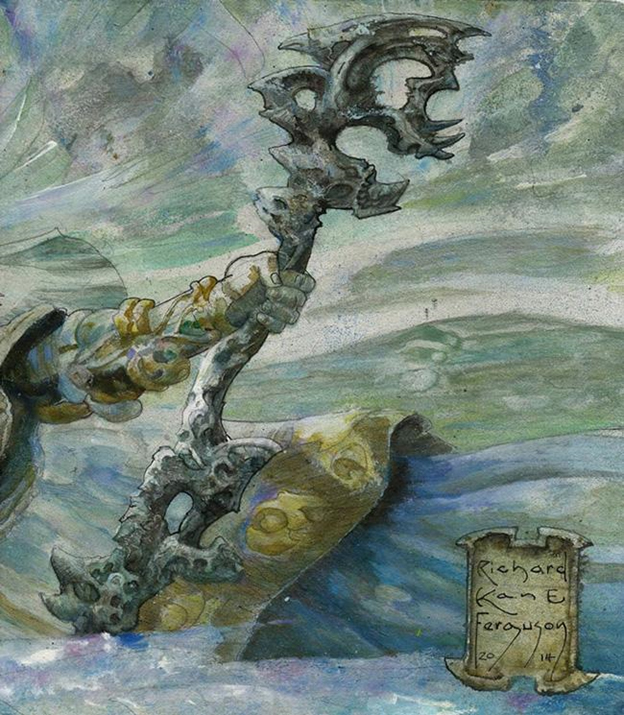
Detail: Lord of the Waves
We see this time and again as Richard continues to advance his art. Even in more recent pieces in which the color has become more subtle, more refined, there is a strong sense of texture and movement in every aspect of the piece. This is the kind of brushwork that dances along with the viewer’s eye. Every detail of the image—the shape of the armor embossing, the patterns on the cape, even the ridges of the bone staff—is filled with a textured physicality that makes it more real. Strangely, in moving away from the hyperrealism of modern commercial fantasy art, RKF’s work becomes more believable. It omits a lot of the details that confuse the eye, taking a healthy step back from the uncanny valley. He doesn’t spell out every last detail because he doesn’t have to. Instead, he concentrates on the visceral experience of the subject, letting the mind fill in the gaps and leaving the viewer with a more complete image.
Emotional Intelligence
Even before I had a chance to meet him in person, I could tell that Richard’s artwork was of a different level of importance to him, sacred. It’s no mistake that there is a level of contemplative depth and meaning in these images. It requires concentration, patience, and dedication to infuse so much emotional energy into a piece. It is the opposite of the societal expectation of “everything right now.” It exists on its own terms, an island of sanity.
Ever wary of the rabbit hole that is twenty-four-seven connectivity, technology is banned from the barn Richard works in. He finds modern media to be jarring, damaging to his imagination. He tends his mind like a garden, carefully selecting which images will flourish once planted.
“The movies I watch now flood my dreams.”
Richard strictly limits his digital “connections” to avoid losing touch his sense of groundedness—less connected to strengthen his connection.
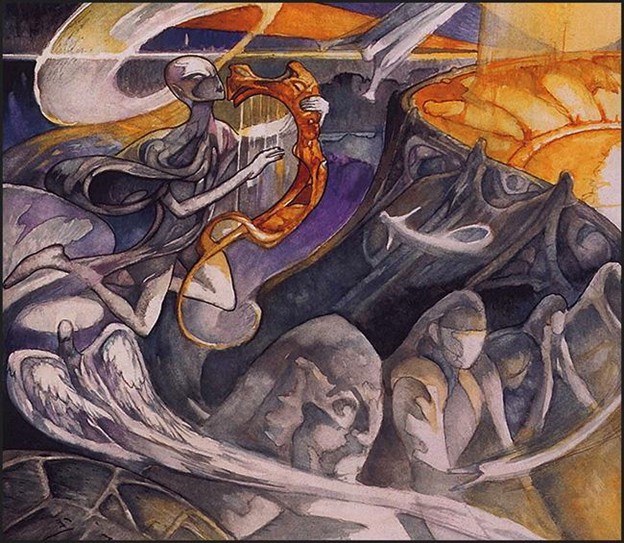
Field of Souls
Ferguson’s artwork always has a touch of the unreal. There is an ethereal quality to his forms and rendering that make his style perfect for fantasy artwork. Even in a field of souls, there is a strong nod toward an innate physicality to the scene. The warm tones on the right side of the piece do more than just balance the composition, they provide narrative. There is a sense of an immense heat, some sort of fire burning just off the frame to the right. The glow of this inferred light source plays across the cooler, more neutral forms, giving them depth and shape. It also reinforces the metallic, chromium finish to the souls themselves, as though they were freshly minted, untainted by their mortal deeds, purified in the fires of the afterlife. The repetition of the figure in the foreground gives the impression of metamorphosis. It all comes together to form a strong narrative of the end of one phase of existence and the transition into the next.
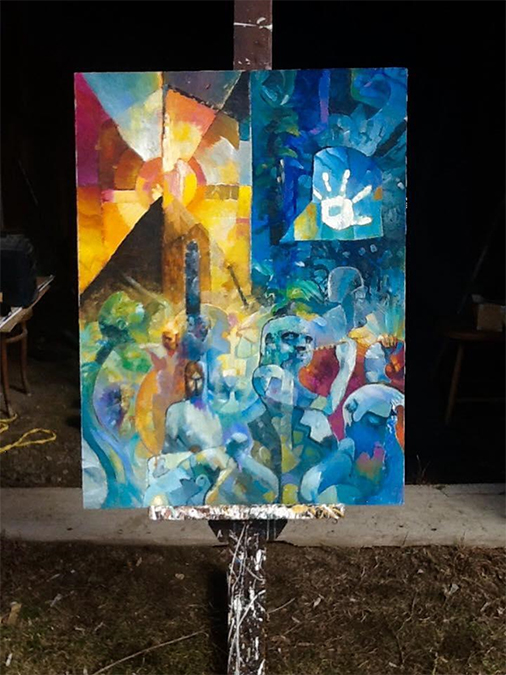
Life of the Ritual
Looking into more recent work, we see Richard easing off the overt narrative. He’s letting the materials tell the story this time. Light and shadow are defined in vivid hues, with the sky blue acting as glue for the whole piece, unifying the design and color scheme in one move. The figures are more fragmented this time through, as though they are in the process of being reassembled from their disparate parts. There is a sense of unity throughout the painting even though the building blocks are identifiably separate. Every brush stroke is purposely visible to extend the narrative and create a deeper sense of connection, a physical and spiritual anchor. This wondrous statement, this stained-glass of pigment, speaks of a highly developed connection and love for the world.
He does so much so well—sometimes, it really does seem mystical. But maybe there isn’t any magic to it at all, no secrets, no hidden treasures. In sticking to his roots, the foundation that draws its strength from fluidity, Richard continues on a journey of unapologetically physical, creative, joy. Ferguson just feels it. And when he feels it, so do you.
What a wonderful time to be along for the ride.
You can find Richard Kane Ferguson on Facebook.














